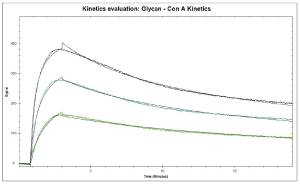Deciding which methods your lab should invest in can be challenging. Cost, experiment time and reproducibility are likely the three most important factors during your evaluation process. We understand that funding is more limited now than ever before, so finding a cost-effective, reproducible method is crucial. Furthermore, there are several pros and cons among various biochemical binding techniques, but since reproducibility is the most critical pillar of scientific discovery, it’s imperative to maintain that trait in your work. How can you ensure that your research is reproducible and impactful? To help answer this question, we’ve compared the pros and cons of two effective techniques for measuring binding, Biolayer Interferometry (BLI) and Surface Plasmon Resonance (SPR).
Blog Overview
What is Biolayer Interferometry (BLI)?
Biolayer Interferometry (BLI) is a label-free binding technique that measures binding kinetics of biomolecular interactions via the physical principle of optical interference. Essentially, one biosensing tip is exposed to light and buffer conditions and then used as a reference; having the remaining tips exposed to experimental conditions. The experimental tips will have one binding partner immobilized, thus forming a layer, and analytes are located in 96 well plates. Once the ligand is immobilized, the tips are “dipped” into the wells, and when an interaction between the two binding partners takes place, the change in thickness of the layer’s tip reflects a change in wavelength. In this respect, binding kinetics are measured in real time.
Pros:
- High throughput
- Low vibrational/mechanical noise
Cons:
- Poor reproducibility (this publication explains the limitations of the technique)
- Relatively high sample consumption
- Should be cross-validated with SPR
BLI has its pros, but it also has its cons; since the technology is still relatively new, there are a few more knots to be untied before full reproducibility is achievable. In stark contrast, Surface Plasmon Resonance (SPR) has been around for well over two decades, and the technology has established itself as a preferred biomolecular interaction analysis technique.
What is Surface Plasmon Resonance (SPR)?
Similar to BLI, SPR is also a label-free binding technique that can measure binding kinetics of biomolecular interactions in real time. Instead of using a tip, a sensor chip which maintains gold coated on a glass substrate with the desired surface chemistry is used to immobilize one of the binding partners onto the surface. The molecule that is immobilized is known as the ligand, and the molecule in solution is known as the analyte. The sensor chip is interfaced with a fluidic system through the use of a small flow cell allowing the analyte to be injected at different concentrations in a very repeatable manner. If you’re new to SPR, think of an HPLC instrument, but instead of using a column at the measurement site, we’re using a sensor chip!
In summary, when light passes through gold, it produces a very distinct absorbance peak at about 550 nm; when an interaction between two proteins, for example, takes place at the surface of the sensor, this peak will shift strongly and subsequently, binding kinetics data can be extracted from this shift.
Pros:
- Very reproducible
- Low-cost
- Minimal sample consumption
Cons:
- Low throughput
Conclusion
All in all, Biolayer Interferometry and Surface Plasmon Resonance are similar in some respects, but the use of a continuous flow system is a significant reason why SPR is more repeatable than BLI. Since BLI technology relies on the “dip and read” method, not enough time is provided for full dissociation to take place, thus skewing the equilibrium constant in a lot of cases.
In the past, BLI had an element of cost-effectiveness when compared to SPR until now. Notably, the OpenSPR is a user-friendly, cost-effective and low maintenance benchtop SPR solution that is used by hundreds of researchers worldwide. To see the data, read our comparison study between the OpenSPR and a BLI instrument the results are quite impressive! Furthermore, here are some publications that demonstrate the quality of data that the OpenSPR will provide. With access to SPR technology on your own lab bench, you can get the high-quality, repeatable data you need to publish faster.

